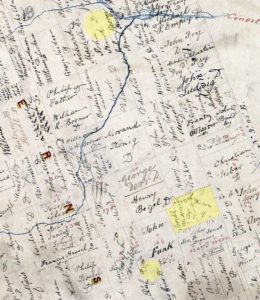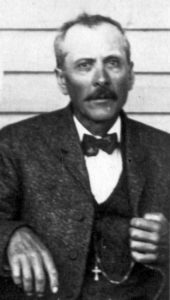
Brick by Brick
This is another post in a series about finding the ancestors of my paternal great-grandfather Joseph Voisin1 (1858-1916). This is a brick wall I haven’t been able to get beyond for several years. Here I chip away a few more bricks from the wall in hopes of discovering a clue.
Perhaps you can help. If you found this post while searching the Internet, chances are there’s something here that piqued your interest. That means you might know something I don’t know. If so, please post a comment. No matter how small, most any information can provide a clue.
In this installment I’ll remove four bricks from the wall. See also Bricks 1 through 10.
Brick 11: Voisin Family from Bentinck, Grey, Ontario
![]() A Voisin family appears in the 1861 Canadian Census in Bentinck Township, Grey County, Ontario. John and Elizabeth Voisin had a son named Joseph about 1856. Although this could be our Joseph Voisin, I’ve not yet researched this family. They apparently emigrated from England and they are Congregationalists. Our Joseph Voisin was very likely of German descent and Catholic.
A Voisin family appears in the 1861 Canadian Census in Bentinck Township, Grey County, Ontario. John and Elizabeth Voisin had a son named Joseph about 1856. Although this could be our Joseph Voisin, I’ve not yet researched this family. They apparently emigrated from England and they are Congregationalists. Our Joseph Voisin was very likely of German descent and Catholic.
Conclusion: Additional research is necessary to prove whether or not this family is related to us.
Brick 12: A Voisin in Waterloo County, Ontario
![]() A man with the Voisin surname appears in the 1861 Canadian Census in Wellesley Township, Waterloo County, Ontario. He was a carpenter, 18 years old, and listed near the Joesph and Catherine (Meyer) Voisin family in the census (see Brick 6). No first name is given and he appears with no other family members.
A man with the Voisin surname appears in the 1861 Canadian Census in Wellesley Township, Waterloo County, Ontario. He was a carpenter, 18 years old, and listed near the Joesph and Catherine (Meyer) Voisin family in the census (see Brick 6). No first name is given and he appears with no other family members.
If this were our Joseph Voisin, he would have been born about 1843 rather than 1858, which is generally accepted. It is curious however. Since Joseph wrote in his journal that he was in Hawkesville in 1877 (see Brick 5), perhaps he had actually been there since 1861.
Conclusion: Additional research is necessary to determine the identity of this Voisin.
Brick 13: Photographs of Joseph Voisin
![]() I have a hunch Joseph Voisin may have been older than he led everyone to believe. I might be able to draw some inferences by examining photographs of him.
I have a hunch Joseph Voisin may have been older than he led everyone to believe. I might be able to draw some inferences by examining photographs of him.
Joseph was a pioneer. He was one of the first settlers in Nottawa Township, Isabella County, Michigan as that area became available to white settlers. (Previously it was reserved for Native Americans.) Joseph was also a farmer. As indicated in an 1880 agricultural census, only four of his forty newly-purchased acres had been improved (cleared for farming). He also was a father to eleven children.
As a pioneer, farmer, and father with all those mouths to feed, he undoubtedly worked very, very hard. Such labor would take a toll on anyone. Therefore, to evaluate how old someone looks in a photograph of that era is difficult.
I’m reminded of a television program, “Frontier House,” in which modern families attempted to live under the same circumstances as 19th century pioneers. In one episode a man became concerned that he was malnourished. It turned out he was dehydrated, but his body was also adapting to the meager food supply and daily labor to which he was not accustomed.
So can I distinguish whether Joseph appears older than his stated age? Or, did the rigors of pioneer and farm life cause him to look older than he was?

Joseph Voisin through Time
The first image was taken about 1907 when Joseph was 49. The middle image was taken about 1912 when he was 54. The last image was probably taken a year before he died, say about 1915, when he was 57.
The question is, do these images look like someone of the stated age, that is 49, 54 and 57, respectively? To me he looks older.
Now to be accurate, there are mitigating circumstances. Joseph did write two recipes for bitters in his journal in the 1890s. He most likely used these as stomach tonics and therefore he may have suffered frequent indigestion and heartburn. Also, he died of prostate cancer, which progressively got worse. He probably suffered for at least a couple years with that. I suspect he may have had other, undocumented ailments besides.
Conclusion: Joseph Voisin may have been older than generally accepted.
Brick 14: The Story of Two Brothers
![]() One account passed down through the generations is that Joseph Voisin came to America in company with a brother. His brother settled in the northern part of Michigan’s lower peninsula.
One account passed down through the generations is that Joseph Voisin came to America in company with a brother. His brother settled in the northern part of Michigan’s lower peninsula.
As with many family stories, there are few details to go on, and no substantiated evidence. I think there may be grains of truth in family lore, but tracking such stories down is difficult. There are Voisin families in northern Michigan, around Traverse City. So this story is plausible.
The trouble is, Joseph Voisin died in 1916, well before any of his grandchildren came of age. Therefore no one now living ever met him and stories told by his children become blurry through time.
Conclusion: Additional research is necessary to determine any connection to the Voisin families of northern lower Michigan.
The saga continues….
Footnotes- For source citations and images of the evidence discussed here, please see the Family Group Sheet for Joseph Voisin.









We have gathered aprox. 15,000 descendants of Joseph Voisin who settled between Heidelberg and St. Clements, Ontario. He is beleived to have left from Le Havre, France. He is the ancestor of all known Voisins in Ontario and beyond. Perhaps you have already been in contact with Frank and/or Clifton Voisin who printed a Voisin book. The problem with this was that if a female Voisin married her descendants were not included which is the case of my morher-in-law Charlotte Voisin who married Robert Voll.
Hi Harvey, Yes, I remember that we spoke before. I did find the ship manifest for Peter Joseph Voisin. He arrived with his brother Henry Joseph Voisin, and his family (https://iseeancestors.com/comm/2017/12/26/voisins-at-new-york/). Both went by the name “Joseph.” Clifton and I proved our relatedness with a Y-DNA test, and therefore I know I’m related to Peter Joseph Voisin. Henry Joseph settled in Welland County, Ontario and I suspect I’m related more closely to him.